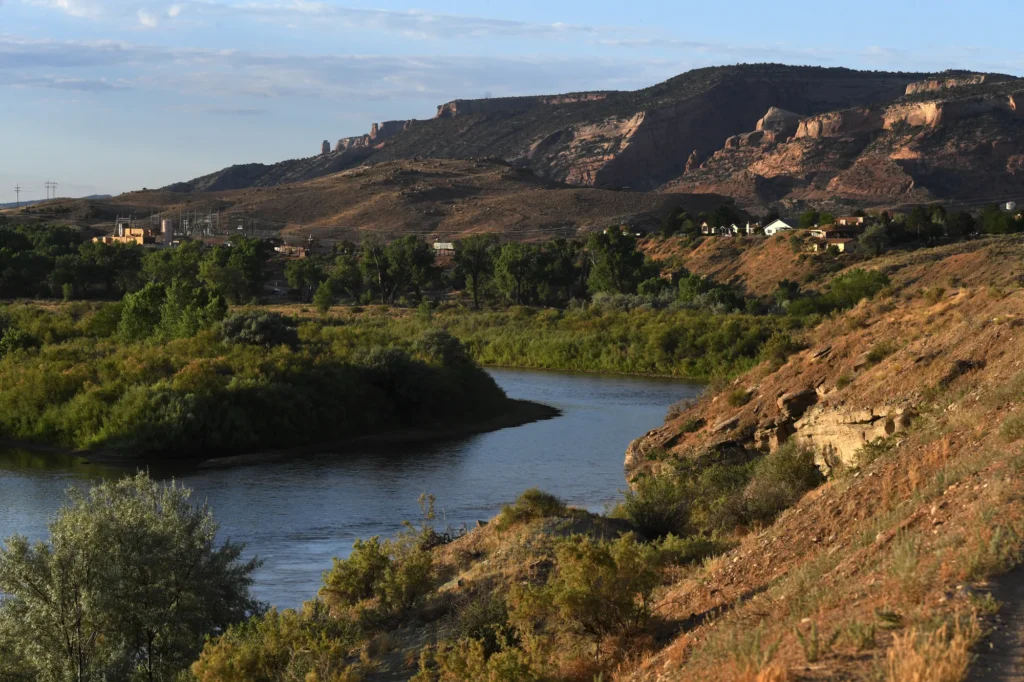The drought-scarred Colorado River Basin lies at the heart of one of America’s most intense resource battles. With billions of gallons of water vanishing and climate stress pushing the system to its breaking point, Western states—plus Native American tribes and Mexico—are locked in a high-stakes negotiation over who gets what.
What’s remarkable right now: while the rhetoric could easily drift into chaos, the Donald Trump administration (yes, that Trump) has so far taken a measured, surprisingly cooperative stance, avoiding the headline-making meltdown many expected. The water war hasn’t exploded into total carnage—yet.
Here’s a closer look at how we got here, what’s shaping the negotiation, and why the federal approach matters for rivers, food supplies, tribes, farms and states alike.
A River in Crisis

The Colorado River is no ordinary waterway—its flow sustains over 40 million people across seven U.S. states, supports 5.5 million acres of agriculture, and crosses into Mexico; it also supports hydropower, ecosystems and dozens of tribal nations. U.S. Department of the Interior+2Colorado Newsline+2
Yet the system is collapsing under its own legacy. The legal framework was built on a 1922 Compact that assumed far more water existed than we now know. Reservoirs like Lake Mead and Lake Powell hover at historic low levels. CalMatters+1
A recent NASA satellite-based study found the basin has lost roughly 27.8 million acre-feet of groundwater over two decades—nearly equal to Lake Mead’s entire capacity. The Guardian
In short: less water is flowing, more is being pumped, and the rules governing it were not built for this climate reality.
The Political Flashpoints
At the heart of the basin’s disarray are several fault lines:
- State vs. state: The Lower Basin (Arizona, Nevada, California) and the Upper Basin (Colorado, Wyoming, New Mexico, Utah) are at odds over who cuts first, and by how much. CalMatters+1
- Tribal rights: More than 30 federally recognized tribes hold senior water rights—often older than state claims—but many are still underserved or sidelined. ICT News
- Mexico: Under the 1944 treaty the U.S. must deliver water to Mexico. In 2025 for the first time since that treaty, the U.S. denied a Mexican request tied to the Colorado River. Water Education Colorado+1
- Agriculture vs. conservation: Farms growing alfalfa or vegetables demand huge volumes; environmental groups push for restoration of river ecosystems and minimum flows. Colorado Newsline+1
The deadline looms: the current operating guidelines expire in 2026, and states must agree to new rules—or the federal government will impose them. CalMatters
The Trump Administration’s Strategy (So Far)
Given the partisan heat around Trump, it would be easy to assume his water strategy would be chaotic—and in some reports, it has been. For example, an Executive Order triggered billions of gallons of irrigation water being released from California reservoirs in what officials called a “political stunt.” The Guardian
Yet on the Colorado River itself, the administration has adopted a more pragmatic tone:
- The Interior Department, under Trump, announced 18 short-term agreements with tribal, city and agricultural partners in the Lower Basin to save roughly 321,000 acre-feet of water by 2026—about five feet of Lake Mead elevation. U.S. Department of the Interior
- The administration paused key conservation funding—$4 billion in programs tied to the Inflation Reduction Act were frozen. � That pause stirred concern, yet it also presents a signal: Trump is prioritizing federal oversight and control rather than letting long-term funds flow unchecked. KUNC+1
- Mexico denial: By rejecting Mexico’s water request under the treaty for the first time in decades, the administration is signaling zero tolerance for treaty non-compliance, even if it adds diplomatic tension. Water Education Colorado+1
In other words: the flashiest headlines are mostly elsewhere—but the foundation of how the federal government engages on the Colorado River is shifting subtly.
Why This Matters for Climate, Communities & Agriculture
This is not just a Western states issue: the ripples spread nationally. Here’s why:
- Food security: A vast chunk of U.S. winter produce comes from farms using Colorado River water. If allocations shrink, food-supply chains get squeezed. New York Post
- Energy & ecosystems: Hydropower from the river and dam systems supports infrastructure. Lower flows threaten power generation, fish habitat, wetlands and tribal lands. CalMatters+1
- Climate justice & equity: Tribes, underserved communities and rural farmers often face the first consequences of cuts—or lack of funds. Their voice matters.
- Precedent-setting: This dispute could redefine how the U.S. handles scarce resources under climate stress—water law, compacts, federal vs. state authority.
In short: the Colorado River equation embodies 21st-century reality—less resource, more demand, more sophisticated solutions—and how the federal government steers this could set the blueprint for other climate-stress zones.
So Why Haven’t We Seen an All-Out War (Yet)?
Several factors explain why the Trump administration’s approach feels “surprisingly straight” instead of chaotic:
- Recognition of urgency: The data is unmistakable—something must be done. Even staunch conservative states and tribes accept this.
- Short-term action vs. long-term overhaul: Rather than sweeping reforms (which could trigger backlash), the administration is doing incremental steps: short-term agreements, funding review, treaty enforcement.
- Leveraging federal authority: By freezing funds or denying requests rather than handing out money freely, the federal government retains leverage in negotiations.
- Avoiding tribal/farm backlash: Major blowouts risk alienating key stakeholders—tribes, states, farmers—which might push them against federal efforts. A measured tone buys more stability.
- Preparing for 2026 operating guidelines: With the deadline looming, the administration appears to be positioning itself to step in if states can’t agree—but with some groundwork laid.
Looking Ahead: Risks & Opportunities
The next 12–18 months will be critical:
- If states fail to reach agreement, the federal government may impose new rules—something Upper Basin states are wary of. CalMatters+1
- Conservation programs still stalled mean legacy imbalances (senior rights, over-allocation, groundwater depletion) remain unresolved.
- If the Trump administration freezes more funding or enforces stricter compliance, smaller farmers, rural communities and tribes may face new pressures—even as larger actors hedge.
- A true paradigm shift may still be required: many experts argue water law must evolve from “first in time, first in right” toward sustainable allocation tied to climate realities. Colorado Newsline
Why This Belongs in the Climate Conversation
Water is climate infrastructure. The Colorado River crisis is the embodiment of climate change meeting legal antiquity. When snowpack shrinks, soils soak up more, temperatures climb, and evaporation increases—water treaties drafted for a wetter era crumble. CalMatters
The federal approach—by holding funds, negotiating agreements, leveraging treaty tools—shows that climate response isn’t always flashy, but it can be strategic. It also illustrates how climate and resource governance must adapt: harder knobs on human systems, not just pumping more money in.
This nexus—climate, law, resource allocation, tribal rights, national food systems—demands solutions designed for scarcity, for competition and for uncertainty. The Colorado River is ground zero for that shift.
Closing Thoughts
For decades, Western leaders have warned of a “structural water deficit” on the Colorado River. As we stand at the edge of that abyss, the Trump administration’s posture so far is less about spectacle, more about positioning: keeping leverage, freezing money, enforcing treaties and nudging states to act.
Whether this incremental strategy holds or cracks under pressure will likely determine whether the water war remains contained—or erupts into full-scale conflict with pandemics, droughts, farms, tribes and states all in the cross-hairs.
The story of the Colorado River—and the federal government’s role in it—is among the most important climate narratives of our time. Readers seeking deeper coverage on how climate change is reshaping water, policy and ecosystems should explore Sustainable Action Now’s Climate category.
The war is not over—just rarely televised.


